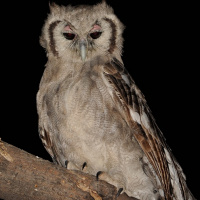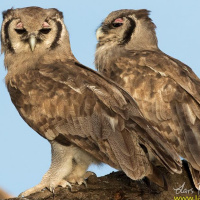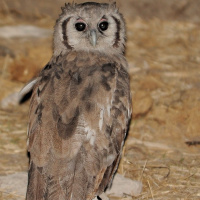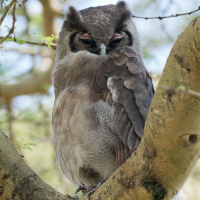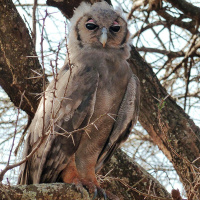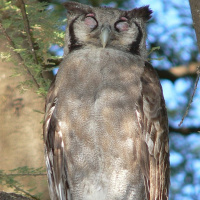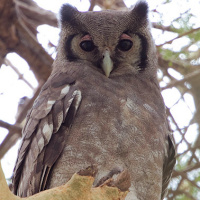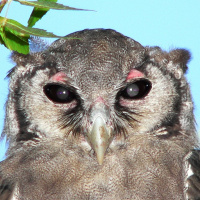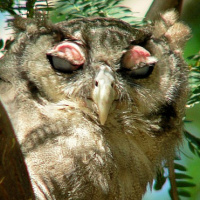Introduction
The Verreaux's Eagle Owl is a very large eagle owl with short, tousled ear-tufts. It is also known as the Milky Eagle Owl or the Giant Eagle Owl. It is the largest owl in Africa.
Photo Gallery (11 pictures)
Sound Gallery
Information
Description: The facial disc is off-white, with a broad blackish rim. Eyes are dark brown, with the upper eyelids being bare and pink with
ochre eyelashes. The bill is pale creamy-horn with a dark grey base. The cere is blue-grey and the bristles around the bill are blackish. Upperparts are pale
grey-brown, suffused 'milky', with fine whitish vermiculations which are darker on the fluffy ear-tufts and on the mantle. The scapulars have large areas of
white, forming a whitish row across the shoulder. Flight and tail feathers are barred light and dark. The throat is white, and quite prominent when calling.
Underparts are paler greyish-brown with fine light and dark vermiculations, darkest on the upper breast and lightest on the flanks and legs. Tarsi are feathered
and toes partially feathered, with the bare parts being greyish-horn. Claws are dark brown with black tips.
Size: Length 60-65cm. Wing length 420-490mm. Tail length 220-273mm. Weight 1615-3115g. Females are larger and heavier than males.
Habits: The Verreaux's Eagle Owl is a generally nocturnal bird, hunting mainly in the early part of the night, but has been known to take prey during the day. Roosts by day on large shaded and sheltered branches, with sites often used over long periods. Regularly bathes in rain or in shallow water.
Voice: An irregularly spaced sequence of deep grunting notes - gwonk gwok-gwok gwonk-gwokwokwok gwonkwogwonk gwonk... This phrase is repeated after several seconds. The female and large young give loud, drawn-out, high piercing whistles when begging for food. A sonorous whok appears to be an alarm call.
Hunting & Food: This owl hunts mostly medium-sized mammals and some larger birds. Mammals include hedgehogs, young monkeys,
warthog piglets, springhares, hares, genets, hyraxes, ground squirrels, fruit bats, rats and mice. Birds range in size from waxbills and weavers up to herons,
Secretary-birds, ducks, francolins and young cranes. Other prey includes reptiles, frogs, toads, fish and arthropods including insects, millipedes, spiders and
scorpions.
Prey is usually caught by gliding down quickly on to it from a perch. Victims up to 1.8kg can be carried off by this owl. Insects may be hawked in flight, while
roosting birds are caught by dashing into foliage. Insects are sometimes chased on foot, and fish are caught by wading into shallow water.
Breeding: Verreaux's Eagle Owls live in monogamous pairs that defend their territory with calls and song, which can carry up to 5km.
During courtship the birds perch near each other, producing fast stuttering hoots, bobbing up and down and flicking open the wings slightly. Allopreening is
frequent. Breeding is annual, mainly in the dry season, but may stretch out to every 2-3 years, possibly according to food supply.
These owls use abandoned stick nests of large birds such as vultures and crows, or sometimes large tree hollows. Generally 2 white eggs are laid
(average 62.5 x 51.4mm) at an interval of about a week. The female incubates the eggs alone, while the male supplies the food. The incubation period is 32-39
days, and young hatch within 7 days of each other. The second chick often does not survive. The female broods the chicks for up to about 20 days, and they leave
the nest at 62-63 days after hatching, and are flying well about 2 weeks after that. They remain hidden in trees or bushes and are rather inactive until about
3 months old. At 5 months they are able to catch prey. Sometimes young remain with their parents for up to 2 years. Sexual maturity is reached at 3-4 years.
Mortality: A captive bird has lived for over 30 years. This owl is persecuted by humans.
Habitat: Dry savanna with scattered trees and thorny shrubs, riverine forest with adjacent savanna, groups of trees and small, semi-open woods in open countryside. Most common in open savanna and semi-deserts, uncommon in well-developed woodland, and absent from dense forest. Ranges from sea-level up to about 3000m.
Distribution: Africa south of the Sahara, south to the Cape.
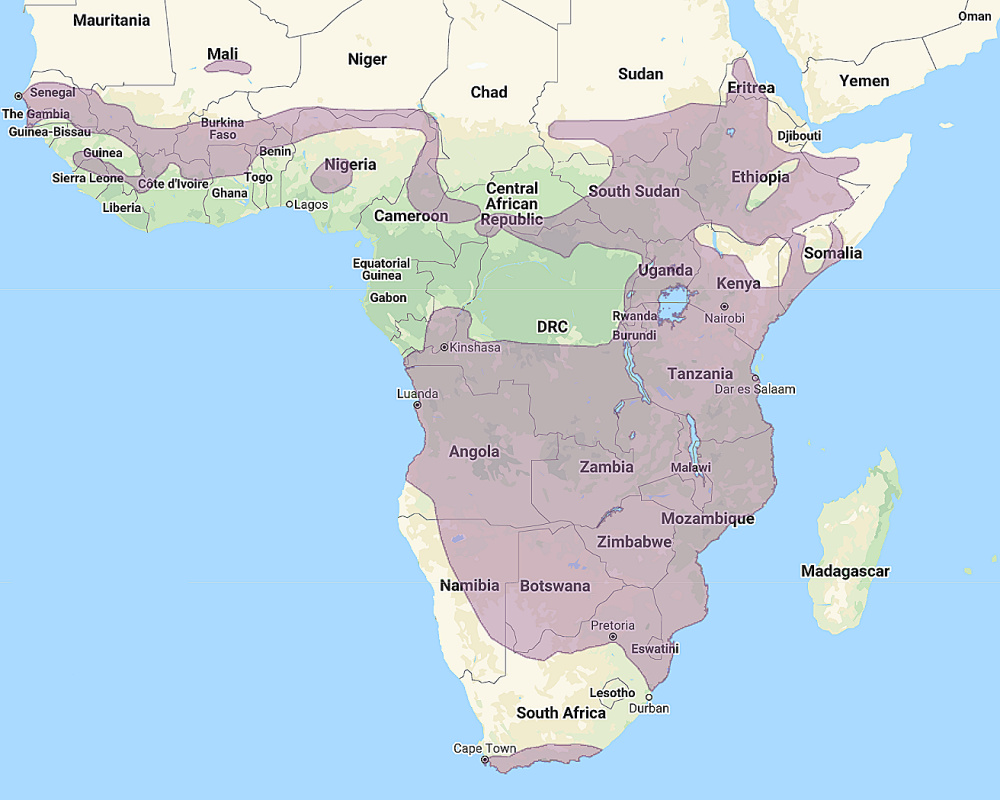
Range of the Verreaux's Eagle Owl Bubo lacteus
Status: Widespread, listed as 'Least Concern' by Birdlife International.
Original Description: Temminck, Coenraad Jacob. 1820. Nouveau recueil de planches coloriees d'oiseaux, pour servier de suite et de complement aux planches enluminees de Buffon: livraison 1, pl. 4.

